Introduction: A Dutch Painter in Flanders
Adriaen de Gryef stands as a fascinating figure bridging the Dutch Golden Age and Flemish Baroque traditions. Born in Leiden, the Dutch Republic, around 1657, he spent the most significant part of his prolific career in the Southern Netherlands, particularly in Ghent, Antwerp, and Brussels. He carved a distinct niche for himself as a painter specializing in meticulously detailed still lifes, particularly those featuring game, hunting dogs, and outdoor settings. While his exact death date remains debated by scholars, often cited as either 1715 or 1722, his activity firmly places him in the vibrant artistic landscape of the late seventeenth and early eighteenth centuries.
De Gryef's work is characterized by its fine execution, elegant compositions, and a keen observation of the natural world. He captured the textures of fur and feather, the glint of light on hunting equipment, and the quiet stillness of captured game with remarkable skill. Though perhaps not reaching the towering fame of contemporaries like Rembrandt van Rijn or Peter Paul Rubens, De Gryef excelled in his chosen genre, creating works that appealed to patrons interested in the themes of the hunt, nature, and decorative display. His legacy resides in numerous European museums and private collections, testament to his enduring skill and specific appeal.
Early Life and Artistic Lineage in Leiden
Adriaen de Gryef's artistic path was perhaps influenced, if not predetermined, by his family background. He was born into an environment steeped in art. His grandfather was none other than the celebrated Dutch landscape painter Jan van Goyen (1596-1656), a pivotal figure in the development of tonal landscape painting in the Netherlands. This connection immediately places the young De Gryef within a significant artistic lineage, although his own style would diverge considerably from his grandfather's atmospheric vistas.
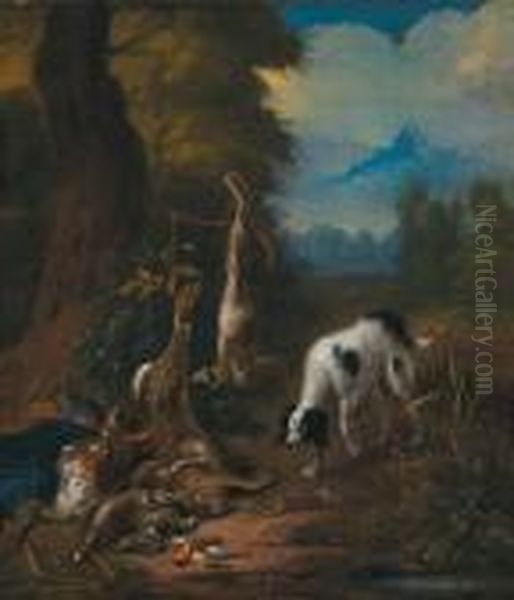
More directly influential was his father, Jacques de Claeuw (c. 1623-1694), who was also known by the surname Grief or Gryef, which Adriaen adopted. Jacques de Claeuw was himself a respected still life painter, known particularly for his vanitas still lifes and sumptuous compositions, often working in Leiden and later The Hague. Adriaen received his initial training directly from his father, learning the fundamentals of still life painting, composition, and the careful rendering of objects and textures – skills that would become hallmarks of his own mature work. Growing up in Leiden, a major artistic center that had nurtured Rembrandt and Gerard Dou, would have exposed him to a high standard of technical proficiency and realism.
A Career Forged in Flanders: Ghent, Antwerp, and Brussels
While born and trained in the Dutch Republic, Adriaen de Gryef sought his professional fortunes primarily in the Southern Netherlands (Flanders). Around the age of 30, he made a significant move to Ghent. His talent was recognized, and in 1687, he was accepted as a master into the Ghent Guild of Saint Luke, the professional organization for painters and other artists. This membership was crucial, granting him the right to take on pupils and sell his work officially within the city.
His stay in Ghent appears to have been relatively brief but significant. In 1689, just two years after joining the Ghent guild, records show he married Anna Francisca Marais. Shortly after his marriage, De Gryef relocated again, this time to Antwerp, another major artistic hub with a rich history dominated by figures like Rubens and Van Dyck. He continued to practice his art there for several years, eventually joining the Antwerp Guild of Saint Luke in 1698, further solidifying his professional standing in the Flemish artistic community.
However, it was Brussels that would become the primary center of De Gryef's activity for the remainder of his career. He moved there sometime in the 1690s, with the first documented mention of his presence dating to 1694. His reputation continued to grow, and in 1699 (some sources state 1694, possibly referring to an initial role), he was appointed as a teacher or dean ('leraar') within the Brussels Guild of Saint Luke. This position indicates considerable respect among his peers and underscores his established status in the city's art world. He remained active in Brussels until his death, producing many of the works for which he is best known today.
Artistic Style: The Hunt, Animals, and Detailed Realism
Adriaen de Gryef specialized in a particular subset of still life and animal painting. His most characteristic works depict the results of the hunt – arrangements of dead game birds (partridges, songbirds, waterfowl), hares, and occasionally larger animals, often accompanied by hunting dogs (typically spaniels or hounds) and accessories like hunting horns or game bags. These compositions are usually set in outdoor environments, often wooded landscapes or park-like settings, which serve as backdrops rather than primary subjects.
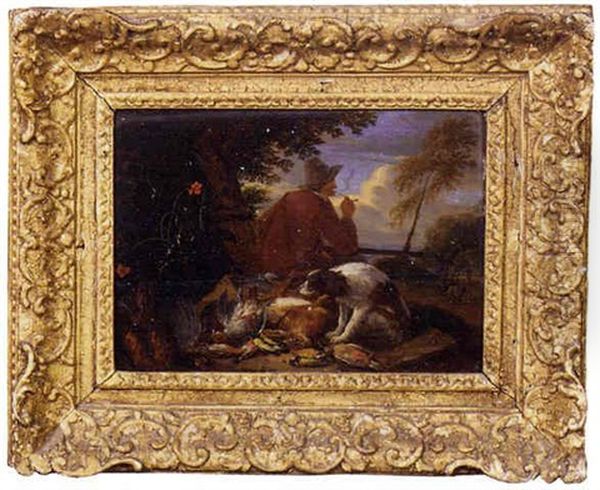
His style is marked by meticulous attention to detail and a high degree of realism. He rendered the textures of fur, feathers, foliage, and earth with painstaking care, employing fine, precise brushwork. This detailed approach aligns him with the tradition of Dutch 'fijnschilders' (fine painters) like Gerard Dou or Willem van Mieris, although his subject matter differed. His compositions are often described as elegant and decorative, carefully arranged to create a balanced and visually appealing scene, suitable for adorning the homes of affluent patrons.
De Gryef demonstrated a strong understanding of light and shadow, using chiaroscuro not in the dramatic manner of Rembrandt, but more subtly to model forms, create depth, and highlight specific textures within the composition. His palette is generally rich and naturalistic, accurately capturing the colours of the animals and landscape elements. While primarily a still life painter, his ability to depict animals, particularly dogs, with lifelike postures and expressions adds vitality to his scenes. His work shows affinities with other Flemish specialists in this genre, most notably Jan Fyt (1611-1661), a leading master of animal and hunting still lifes, and perhaps also Pieter van der Eelen, another contemporary active in similar themes.
Themes and Subject Matter
The dominant theme in Adriaen de Gryef's oeuvre is the hunt and its spoils. This subject matter was popular among the aristocracy and wealthy bourgeoisie in the 17th and 18th centuries, reflecting their leisure activities and status. His paintings often function as 'nature morte' (dead nature), presenting carefully arranged compositions of game animals. These works celebrate the bounty of nature while also serving as reminders of mortality, akin to the vanitas tradition his father practiced, though Adriaen's focus was less overtly allegorical.
Dogs are recurring and important figures in his work. They are not merely accessories but active participants or observers within the scene, often depicted guarding the day's catch or gazing expectantly. His skill in rendering different breeds, particularly hunting dogs like spaniels, shows careful observation. These depictions add a narrative element, suggesting the moments just after the hunt has concluded.
While landscapes feature prominently as settings, they are typically subordinate to the still life elements in the foreground. They provide context – a forest clearing, the edge of a park – enhancing the naturalistic feel of the scene. Unlike his grandfather Jan van Goyen, De Gryef was not primarily a landscape painter; the landscape served the still life. Occasionally, he painted scenes that included live animals or small figures, such as huntsmen in the distance, adding a touch more narrative or genre element, as seen in titles like Huntsman and Dogs.
Representative Works
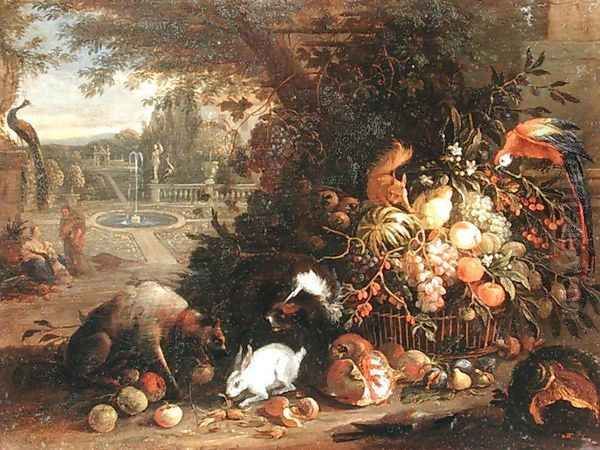
Several paintings exemplify Adriaen de Gryef's style and thematic concerns. While a comprehensive catalogue raisonné might be lacking, certain works are frequently cited:
Cacciagione (Hunting Scene / Game Piece): Housed in the Royal Museums of Fine Arts of Belgium (Musée des Beaux-Arts) in Brussels, this work is considered representative of his Brussels period. It likely features a typical arrangement of dead game, perhaps with hunting dogs, showcasing his detailed technique and compositional skill within his preferred genre.
Dogs and Dead Game: This painting, reportedly held in the collection of the Iziko South African National Gallery, directly reflects his core subject matter. It would likely depict hunting dogs alongside various types of game birds or animals, emphasizing the textures of fur and feathers and set within a landscape.
Still Life in a Garden: This title suggests a slightly different setting, perhaps incorporating more elements of flora alongside fauna or still life objects. It points to a potential variation within his output, moving beyond the immediate post-hunt scene to a more cultivated natural environment.
Still Life with Songbirds: Focusing specifically on smaller birds highlights De Gryef's ability to render delicate forms and plumage with precision. Such works would have appealed for their decorative quality and intricate detail.
Huntsman and Dogs: This title indicates a work with a stronger narrative or genre element, including human figures (the huntsman) alongside the animals, likely depicted in a landscape setting during or after a hunt.
A spaniel with a dead heron and other birds in a wooded landscape, huntsmen and their dogs beyond: Sold at auction, this work (21.1 x 29.1 cm) provides a specific example of his compositions, combining a foreground still life of game (heron, other birds) with a hunting dog, set against a wooded backdrop featuring distant figures, blending still life, animal, and landscape elements.
An elegant company after the hunt: Mentioned in auction listings, this title suggests a more complex scene, possibly involving multiple figures enjoying the spoils of the hunt, hinting at genre painting influences alongside his typical still life focus.
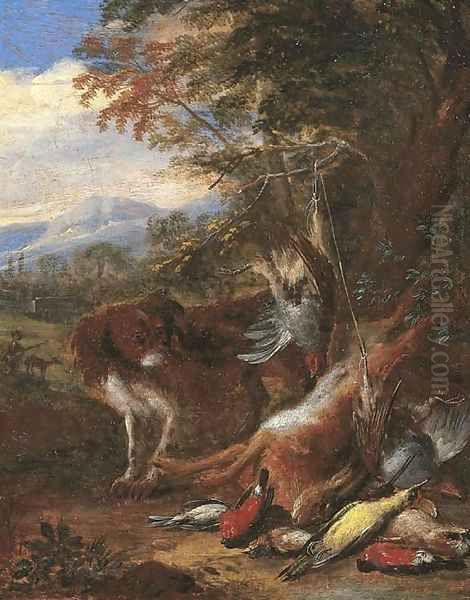
The painting noted in the Musée des Beaux-Arts de Tournai, reportedly dated 1622, presents a chronological impossibility given De Gryef's birth year of 1657. This is likely a transcription error in the source material, perhaps intending 1722 (consistent with his later years) or referring to a misattributed work. If dated late in his life (e.g., c. 1715-1722), it would represent his mature style.
Context and Connections: The Artistic Milieu
Adriaen de Gryef operated within a rich and complex artistic environment. His career spanned the late Dutch Golden Age and the continuing traditions of the Flemish Baroque. While trained in Leiden, his move to Flanders placed him in a region with a distinct artistic identity, heavily influenced by the legacy of Peter Paul Rubens (1577-1640) and Anthony van Dyck (1599-1641), known for their dynamic compositions and often grander scale. However, De Gryef's intimate and detailed style aligns more closely with Flemish specialists in still life and animal painting.
His most significant artistic kinship lies with Jan Fyt (1611-1661). Although Fyt belonged to an earlier generation (he was a pupil of Frans Snyders, 1579-1657, another giant of Flemish animal painting), his elaborate hunting still lifes set the standard for the genre in Flanders. De Gryef clearly worked within the tradition Fyt had established, focusing on similar subjects and aiming for a high degree of realism and textural richness. Comparisons are also drawn with Pieter Boel (1622-1674) and Pieter van der Eelen, contemporaries who also specialized in game pieces and animal subjects.
While direct connections to the Rembrandt school are speculative, De Gryef would have been aware of the broader trends in Dutch and Flemish art, including the dramatic use of light and shadow (chiaroscuro) popularized by Rembrandt (1606-1669) and his followers. De Gryef employed light effectively, but generally with less theatricality than Rembrandt or Caravaggisti. His meticulous technique echoes the Leiden 'fijnschilders' like Gerard Dou (1613-1675), though applied to different subjects than their typical genre scenes. He worked during a period when other notable Dutch artists like Jan Steen (c. 1626-1679), known for lively genre scenes, and landscape painters following the tradition of his grandfather Van Goyen, were active. In Flanders, contemporaries included genre painters like David Teniers the Younger (1610-1690) and artists continuing the grand Baroque tradition like Jacob Jordaens (1593-1678) in his later years. De Gryef's specialized niche occupied a distinct space within this diverse landscape.
Legacy, Collections, and Reception
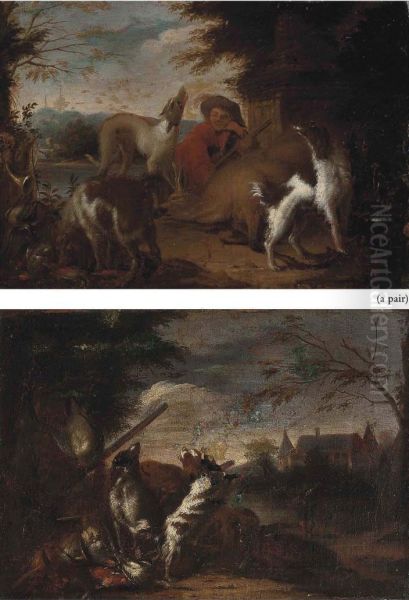
Adriaen de Gryef achieved considerable success during his lifetime, evidenced by his acceptance into multiple guilds and his teaching role in Brussels. His works found a ready market among patrons who appreciated his specialized subject matter and detailed execution. Today, his paintings are represented in several significant European public collections, including the Royal Museums of Fine Arts of Belgium in Brussels and the Musée des Beaux-Arts in Tournai. The presence of a work in the Iziko South African National Gallery suggests a broader historical distribution, likely through colonial-era collecting or later acquisitions.
His works also appear periodically on the art market, handled by auction houses such as Christie's, Wannenes Art Auctions, Pandolfini, and featuring in specialized sales of Old Master paintings. Auction records indicate that his paintings, such as A spaniel with a dead heron... (estimated £2000-3000 in 2015) or a landscape titled Frost草原 (Frosty Meadow/Landscape?, estimated €3000-5520 in 2014), command respectable prices, though generally not reaching the levels of the most famous Dutch or Flemish masters. This reflects his status as a skilled specialist rather than a leading innovator of his time.
There was a period where De Gryef's reputation waned, and his works were sometimes misattributed to more famous contemporaries like Jan Fyt or even lesser-known artists like Pieter van Cleve. This confusion underscores the challenges in definitively attributing works within specialized genres where styles could be similar. However, modern art historical scholarship has worked to clarify his oeuvre and reassess his contribution.
The uncertainty surrounding his exact death date (1715 vs. 1722) is a minor point of scholarly debate but doesn't detract from the understanding of his career trajectory, which firmly places his main activity between the 1680s and the early 1710s or 1720s. Recent interest and research have helped to restore his identity as a distinct and talented painter within the Flemish tradition of animal and still life painting.
Conclusion: A Master of Detail in Nature Mort
Adriaen de Gryef emerges from the historical record as a highly skilled painter who mastered a specific and popular genre: the hunting still life. Born in the Dutch Republic and benefiting from an artistic family background including Jan van Goyen and Jacques de Claeuw, he built his successful career primarily in the Flemish cities of Ghent, Antwerp, and especially Brussels. His membership and teaching role in the artists' guilds attest to the respect he garnered among his peers.
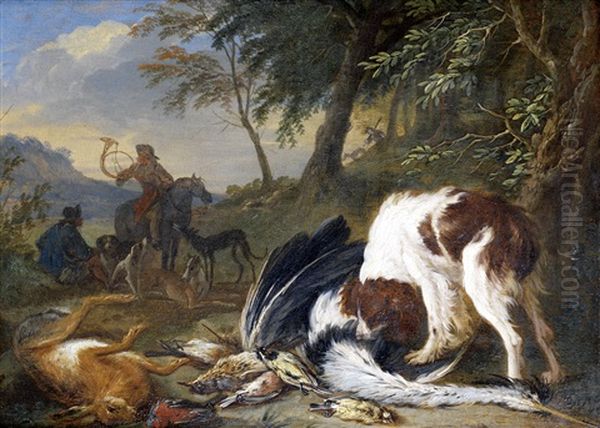
His paintings are admired for their meticulous detail, realistic rendering of textures like fur and feathers, elegant compositions, and sensitive depiction of animals, particularly hunting dogs. While working in the shadow of giants like Rubens, Rembrandt, and Van Dyck, and closely aligned with the tradition of Flemish animal specialists like Jan Fyt and Frans Snyders, De Gryef developed a recognizable style characterized by fine execution and a focus on the quiet aftermath of the hunt.
Though his fame may have fluctuated over the centuries, with periods of neglect or misattribution, Adriaen de Gryef's works remain appreciated today in museum collections and on the art market. He stands as a significant representative of the late Baroque period's interest in detailed naturalism and the themes of nature and the hunt, a master of his chosen craft whose paintings continue to offer a window onto the tastes and artistic standards of his time. His contribution lies in the consistent quality and distinctive charm of his specialized output.